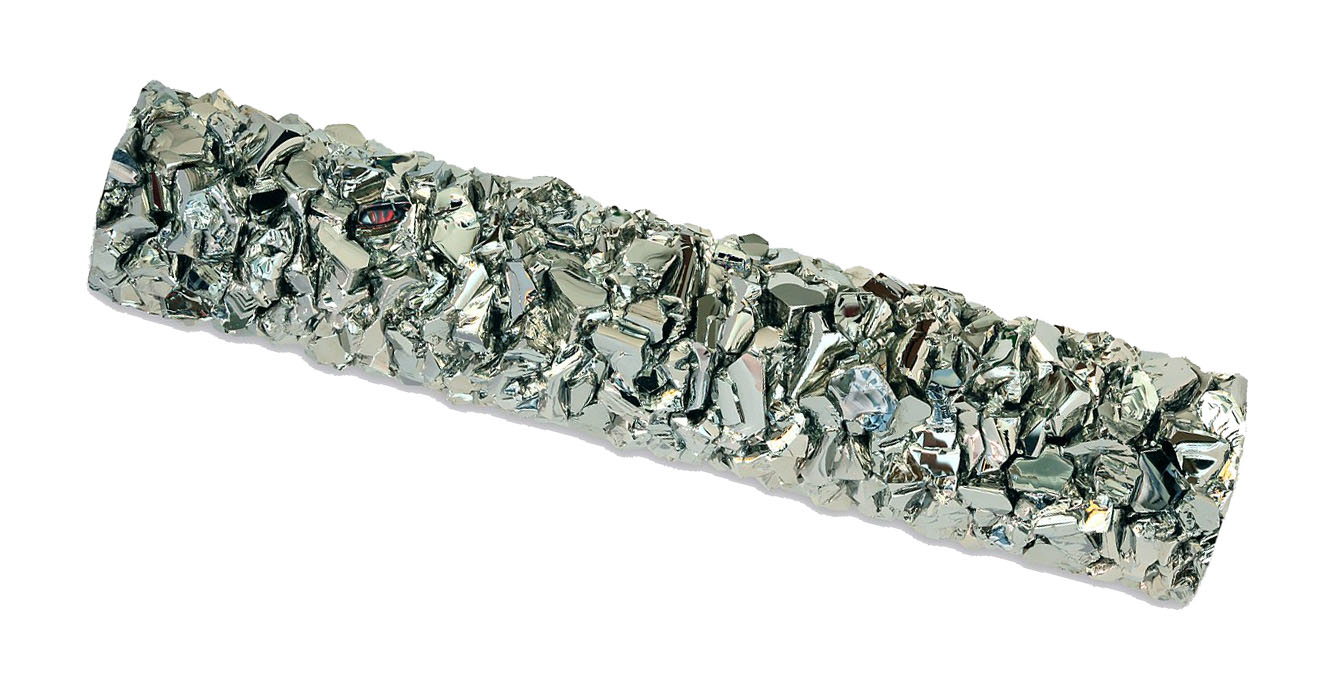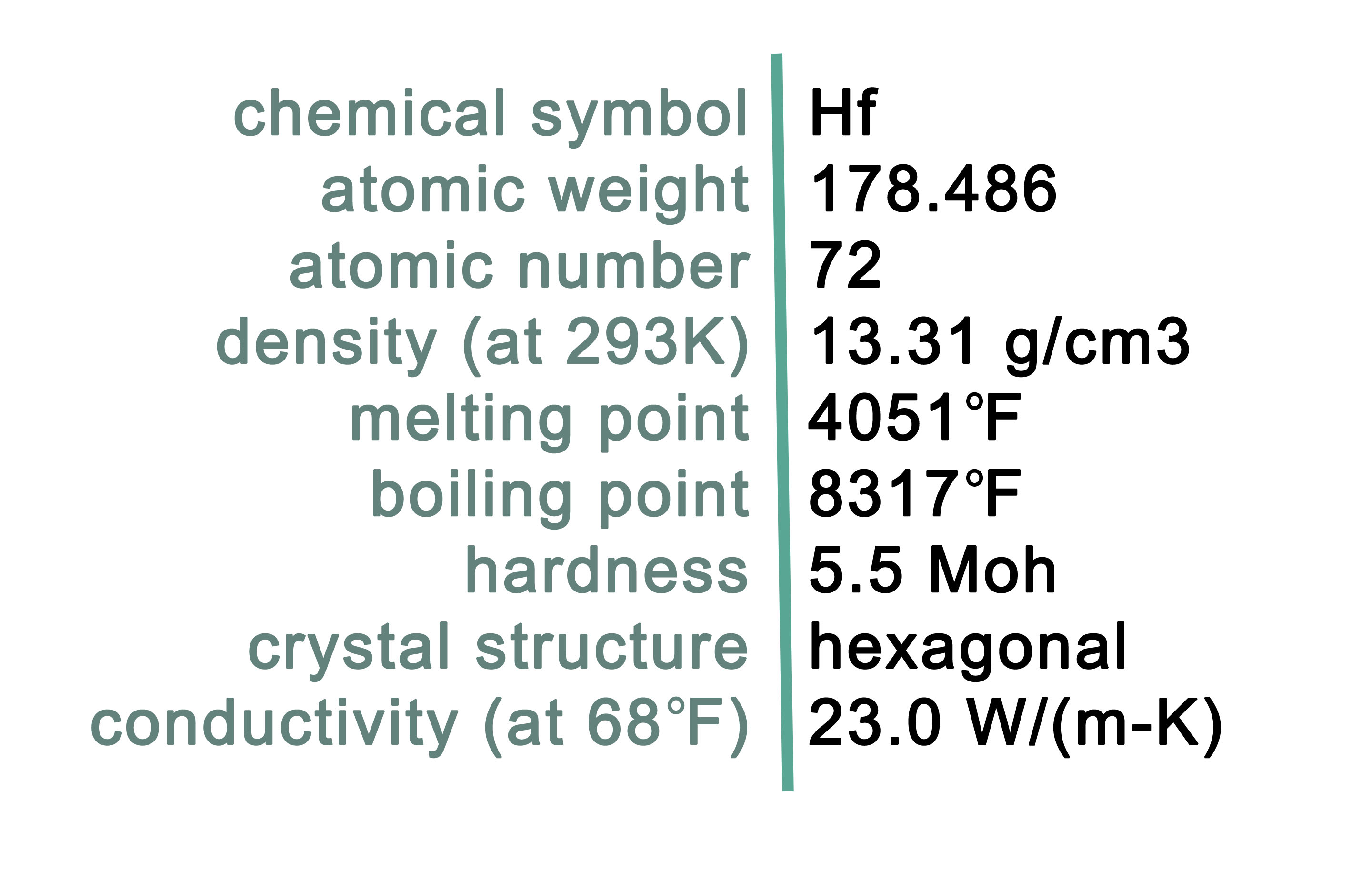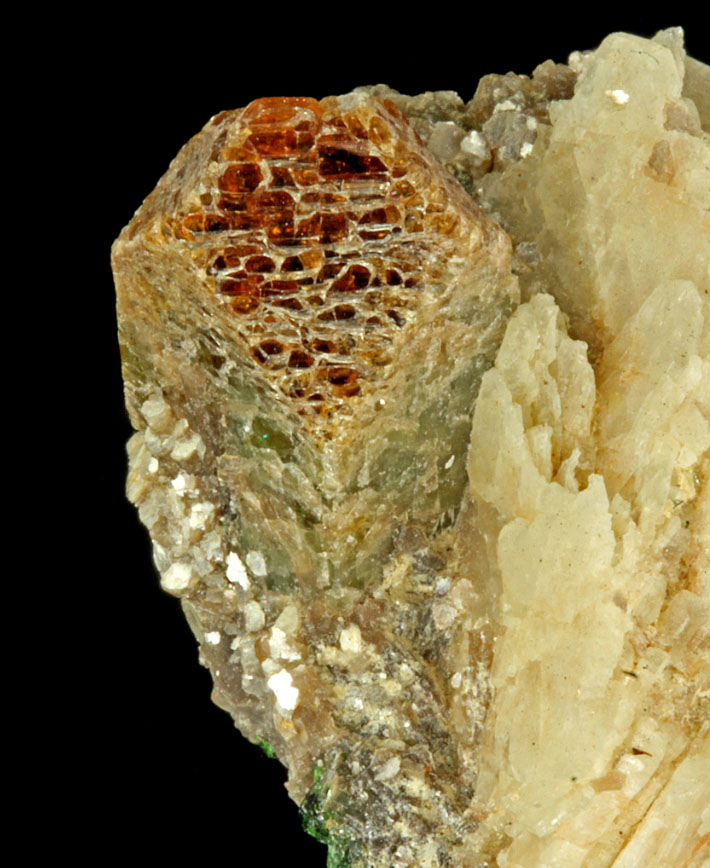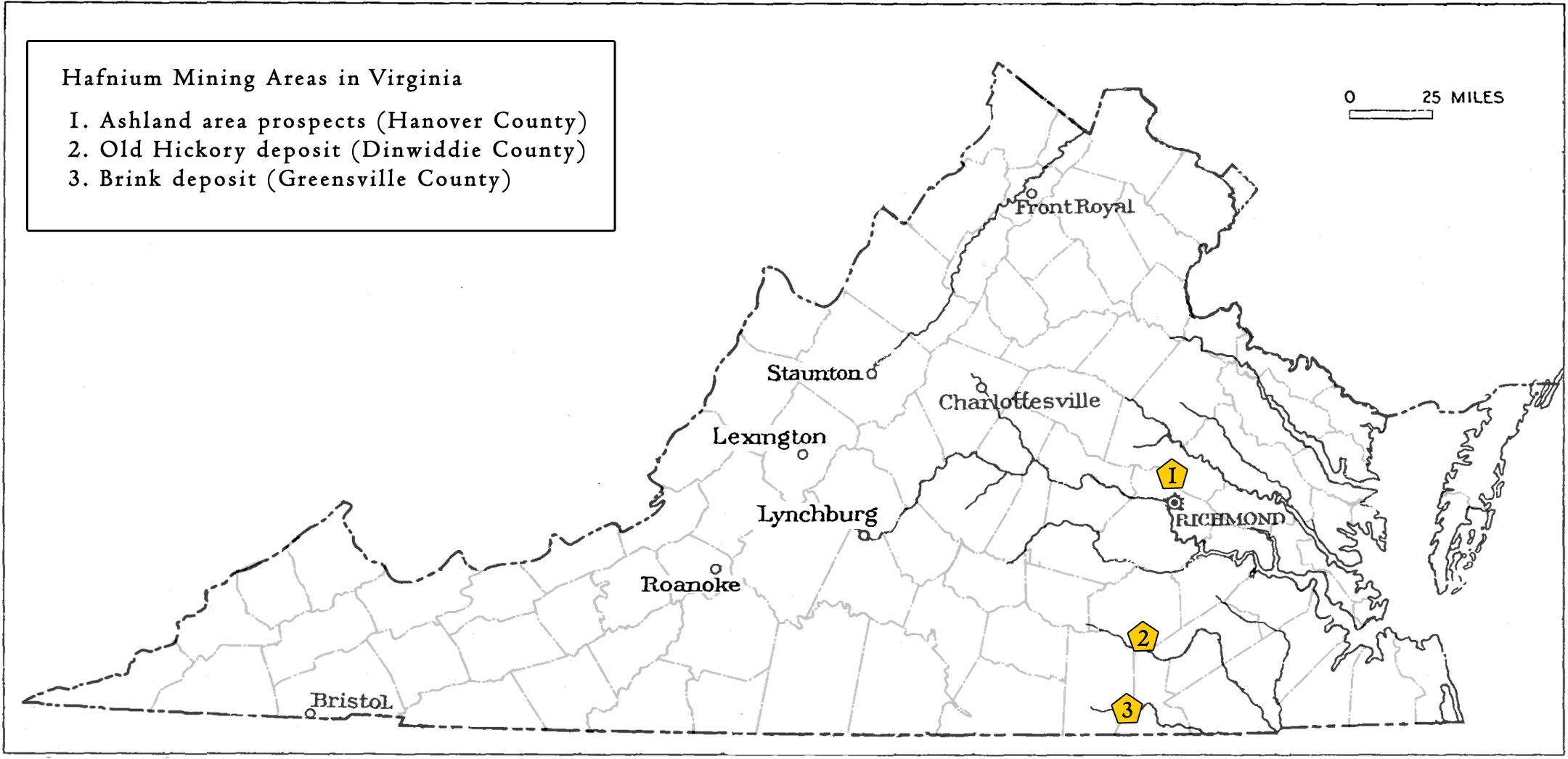Characteristics of Hafnium
The element hafnium is a silvery metal with a high density. Hafnium is a lustrous metal with the chemical symbol Hf. When exposed to air, it forms a durable oxide film which is highly resistant to corrosion. Hafnium is almost always found together with the element zirconium (Zr). Hafnium is a ductile metal and as a fine powder is highly flammable. It is associated with zirconium-containing minerals such as zircon, or more rarely as the mineral hafnon (Table 1).


| Mineral Name | Chemical Formula | Specific Gravity | Hf % |
|---|---|---|---|
| Zircon | Zr(Hf)SiO4 | 4.6 - 4.7 gm/cc | 4.69 |
| Baddeleyite | Zr(Hf)O2 | 5.75 gm/cc | variable |
| Hafnon | HfSiO2 | 6.97 gm/cc | 58.45 |
Table 1: Minerals containing the element Hafnium

Microchips contain metals such as hafnium.
Courtesy Richard Wheeler, https://en.wikipedia.org/wiki/Integrated_circuit
Uses of Hafnium
Hafnium is considered a "critical mineral" in domestic metallurgical applications that serve aerospace, defense, and energy technologies (Fortier and others, 2018). Due to its striking similarities to the element zirconium, hafnium was not recognized as its own element until 1923. It is difficult to separate from zirconium. When it is pure, it is primarily used in the nuclear industry in control rods for nuclear reactors. Hafnium is also used as a metal alloy to improve corrosion resistance. Hafnium may be used as a component in microprocessors and plasma torches, and for high-temperature ceramics. Like its partner element zirconium, hafnium is also used by scientists for geochronology.

A hafnon crystal.
Courtesy Weinrich Minerals, https://www.weinrichmineralsinc.com/
Hafnium Geology
Hafnium often forms with the element zirconium in igneous and metamorphic rocks. Hafnium originates from the cooling and crystallization of magma as it mixes with the surrounding rock in the Earth's crust, where hafnium is common. Igneous rock forming from deep mantle-sourced magma may have a greater concentration of hafnium, as the shallow mantle is relatively depleted in the element. Because minerals containing zirconium and hafnium, such as zircon, are highly resistant to weathering, they eventually erode out of host rocks and may accumulate elsewhere as heavy mineral sand placer deposits. Economic deposits of heavy minerals may be found in modern sediment accumulations as well as in ancient beach deposits that may be far inland from today's shorelines.
| Mineral System | Deposit Type | Geologic Provinces |
|---|---|---|
| Placer | Heavy mineral sands | Blue Ridge |
| Porphyry | Post-magmatic quartz-sulfide veins in greisen; granodiorite | Blue Ridge |
Table 2: Prospective hafnium mineral systems, deposit types (Hofstra and Kreiner, 2020), and geologic provinces in Virginia
Hafnium in Industry
Like zirconium, the element hafnium is globally distributed, but generally in low concentrations. Hafnium usually exists with zirconium in the mineral zircon at a ratio of 50:1 (zirconium to hafnium) or within the mineral baddeleyite at a ratio of 73:1. Heavy mineral sands mining projects are in progress in China, Australia, and Siberia (USGS, 2020). The U.S. maintains a supply of hafnium in the National Defense Stockpile, and is a net exporter. In the United States, hafnium is mined in Florida and Georgia. Concerns related to mining for zirconium and hafnium include erosion from surface mining, disruption of the surrounding ecosystem, and inhalation of zirconium dust during industrial processing.
In Virginia, hafnium and zirconium are primarily from the mineral zircon sourced from deposits of heavy mineral sands. The heavy minerals were naturally concentrated by wind and wave action in beach and sand dunes about 3 to 4 million years ago during the Pliocene Epoch, when the shoreline of the Atlantic Ocean was at a higher elevation (near Richmond). The ancient coastline is now exposed in Dinwiddie and Greensville Counties, where zircon occurs as paleoplacer deposits.
Hanover CountySeveral historic prospects for zirconium and possibly hafnium (from Zircon) have been reported near the town of Ashland in the Hanover County. Samples of sandstone rich with ilmenite and zircon were identified in 1910 along the contact of the Petersburg Granite and overlying Calvert Formation sands. Although samples contain approximately 30 percent zircon by weight, the area was not industrially mined (Watson and Hess 1913).

Areas prospected or mined for hafnium in Virginia

The Concord heavy mineral sands mine.
USGS, Bradley Van Gosen
In 1996, mining and processing of heavy mineral sands began from the Old Hickory deposit, located in Dinwiddie County. A second mine (Brink) was permitted about 19 miles to the south in Greensville County in 2008. At both sites, heavy mineral sands were mined by excavator and then processed to separate each heavy mineral (ilmenite, leucoxene, rutile, and zircon) by weight and magnetism. More details on current and historical mining of these deposits is on the heavy mineral sands webpage.
Selected References:
Bedinger, G.M., 2017, Zirconium and Hafnium: U. S. Geological Survey 2015 Minerals Yearbook, p. 86.1-86.7
Berquist, C.R. Jr., 1990, Chemical analyses of offshore heavy-mineral samples, Virginia inner continental shelf. In: Berquist, C.R., Jr., (ed), Heavy mineral studies - Virginia inner continental shelf: Virginia Division of Mineral Resources Publication 103, p. 109- 124.
Berquist, C.R. Jr., 2010, Heavy Mineral Analyses of Four Samples, Virginia Coastal Plain (October 2010), Virginia Division of Mineral Resources.
Conley, J. F., Fordham Jr., O. M., and Toews, E. C., 1977, Statistical study of Zircon populations from igneous and metamorphic rocks in the Martinsville West Quadrangle, Virginia. Virginia Division of Mineral Resources Open File Report 43.
Fortier, S.M., Nassar, N.T., Lederer, G.W., Brainard, J., Gambogi, J., and McCullough, E.A., 2018, Draft Critical Mineral List - Summary of Methodology and Background Information - U.S. Geological Survey Technical Input Document in Response to Secretarial Order No. 3359: U.S. Geological Survey Open-File Report 2018-1021, 15 p.
Hawkins, D.W. and Lassetter, W.L., 2022, Geologic map compilation and geochemical investigations in the Earth MRI Virginia Fall Zone placer focus area. Virginia Department of Energy, Geology and Mineral Resources Program Open-file Report 2022-01, 50 p. and Appendices.
Hofstra, A.H., and Kreiner, D.C., 2020, Systems-Deposits-Commodities-Critical Minerals Table for the Earth Mapping Resources Initiative: U.S. Geological Survey Open-File Report 2020-1042.
Lassetter, W.L., and Blanchette, J.S., 2019, Economic heavy minerals on the continental shelf offshore of Virginia - new insights into the mineralogy, particle sizes, and critical element chemistry: Virginia Division of Geology and Mineral Resources Open-File Report 2019-03.
Newton, M.C. and Romeo, A.J., 2006, Geology of the Old Hickory heavy mineral sand deposit, Dinwiddie and Sussex Counties, Virginia. In: Reid, C.J. (ed), Proceedings of the 42nd Forum on the Geology of Industrial Minerals. North Carolina Geological Survey, Information Circular 34, p. 464-480.
Virginia Division of Mineral Resources, 1993, Geologic Map of Virginia: Virginia Division of Mineral Resources, scale 1:500,000.
Watson, T. L. and Hess, F. L., 1913, Zirconiferous sandstone near Ashland, Virginia in Watson, T. L., Biennial report on the mineral production of Virginia during the calendar years 1911 and 1912, Virginia Geological Survey Bulletin 8.
Zirconium and Hafnium, Chapter V in Critical Mineral Resources of the United States - Economic and Environmental Geology and Prospects for Future Supply. U.S. Geological Survey Professional Paper 1802-D


.jpg)
